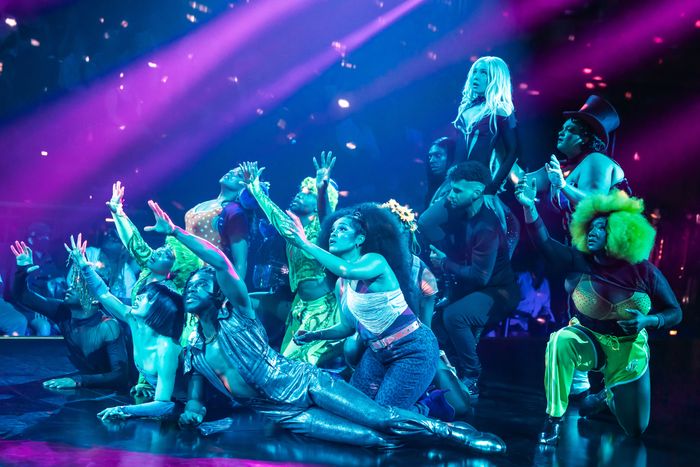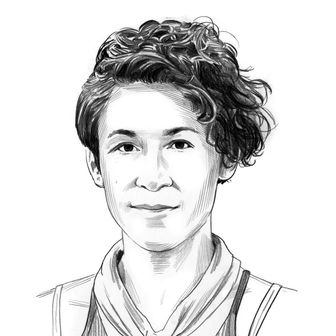
Whatever one may think about Andrew Lloyd Webber, the man is game. Unlike, say, Samuel Beckett, who was relentlessly litigious over productions that diverged from his vision (“Anybody who cares for the work couldn’t fail to be disgusted by this,” he wrote about JoAnne Akalaitis’s set-in-an-abandoned-subway-station Endgame at ART in 1984), Lloyd Webber, at age 76, seems basically up for anything when it comes to new takes on his splashy musical blockbusters. One could argue that what he’s especially up for is cash, and that it’s not the most unreasonable impulse in the world to guard the dramaturgical integrity of Waiting for Godot a bit more closely than that of Starlight Express. But also, theater is a living art, and what creators lose by allowing other creators to dive into their work and mess around with it often feels insignificant, even a little petty, next to what we all have to gain. Maybe the experiment fails — but maybe it produces a kind of sparking, bubbling chemical reaction, where inspiration reinvigorates, even transforms.
This is all my way of saying: The rumors aren’t wrong. “Ballroom Cats” is a really good time.
Cats: “The Jellicle Ball” is the vogueing, waacking brainchild of co-directors Zhailon Levingston and Bill Rauch. It’s a high-spirited mash-up of Lloyd Webber’s possibly most dunked-on musical (the one about cats) with the culture and choreographic stylings of the ballroom scene immortalized in Paris Is Burning. It’s also a tribute to the legends of that scene, living and dead, and an energizing act of cross-community collaboration. A mix of more traditional triple threats with dancers, newcomers, and elders from the ball circuit — as well as a DJ to scribble, juggle, and sample along with the live band — creates a palpable effervescence in the room, banishing any theater in-crowd stuffiness. At intermission, I heard whispers about Steven Tyler being in the crowd. People are stoked, both onstage and off. It’s, as the kids say, a vibe.
It’s also the best use I’ve seen yet of the very big, very expensive, but somewhat unwieldy space at the Perelman Performing Arts Center. So far, PAC NYC has felt to me like one of the many theaters designed by seven-figure architects who’ve never seen a play, but scenic designer Rachel Hauck wakes up the room by capitalizing on its boxiness. A wall of center-pivot warehouse windows backs a long raised runway — a literal catwalk — and if you’ve got VIP-ticket money, you might find yourself sitting at a cabaret table right up in the thick of the action. A fire-escape staircase hangs suspended (a Chekhov’s egress, since we’re waiting for one special cat to ascend to the Heaviside Layer), a tinsel curtain glitters, and the newel caps on the seating-riser handrails are little silver kitties. We are, it feels, a group of gleeful squatters — co-conspirators gathered in some old, abandoned building, thriftily decked out for new glory, passing around the cheap Champagne and crossing our fingers that the cops don’t arrive.
Hauck’s set lays the groundwork for the highly effective — sometimes even uncanny — fusion of this Cats with its concept before a single synthesizer note has been played. After all, the show follows a clowder of fabulous felines as they gather in a junkyard for the “Jellicle Ball,” an event where a revered elder will choose one of them to “be reborn / And come back to a different Jellicle life.” The cats introduce themselves and strut their stuff. A cat emcee teaches us cat rules and customs. The cats are each specific, outsize, competitive, and dramatique, and, as their master of ceremonies, Munkustrap (Dudney Joseph Jr.), informs us, they all possess “three different names: a “sensible, everyday” name, a “particular name” that allows them to “cherish [their] pride,” and — most importantly — a “deep and inscrutable singular name,” secret to all but the self.
Perhaps it would shock T. S. Eliot (or perhaps not at all) to find that he wrote, along with some zhuzhing-up from Lloyd Webber, such an apt description of living in a queer body — and, even more fittingly, a queer body that joyfully experiments with identity and performance. When Levingston and Rauch’s Cats is at its best, its metaphors slot into place with almost prefabricated neatness. It’s hardly a leap, more of a flirtatious little feline step, to imagine the show that each cat puts on as part of an all-out runway-stomping ballroom competition. The character groupings naturally become houses (Jennyanydots, played by Xavier Reyes, is the Bianca Del Rio–ish mother of the House of Dots, whereas Antwayn Hopper’s Macavity, a flamboyant thief of an orange boi, is the father of the House of Macavity).
Munkustrap keeps the party rolling with the regular announcement of competition “cat-egories” (“Virgin Vogueing” shows off the insane moves of Baby, a young voguer from Queens serving Ariana Grande, and Primo, a ballet-trained member of houses in both the “main” and Kiki scenes). And the cat world’s reverence for its elders needs no translation, as Junior LaBeija — a member of the House of LaBeija who appeared in Paris Is Burning — brings a kind of floating, self-possessed opulence to Gus, the grand old “theatre cat.” More majestic still, the 78-year-old powerhouse André De Shields threatens to cause a riot with his entrance as Old Deuteronomy.
Qween Jean’s geyser of kaleidoscopic costumes is a nonstop delight, but still, Deuteronomy is something special: In a shimmering purple suit and a leonine cascade of white-to-lavender ombré locks, De Shields is a psychedelic Aslan — this is his ball, and these kittens are his pride. Jean is also doing ingenious work threading felinity through the costumes without slipping over the line into cheese (which is different from camp, darling). A pointed-ears cap on Tumblebrutus (the elastic-limbed Primo), an incredible tiger-striped fall of a wig on Skimbleshanks the “railway cat” (Emma Sofia, making an MTA uniform hotter than it has any right to be), leopard print deployed in ways both impish and entirely credible, fur everywhere — it all does the trick with full exuberance and without cringe.
The same can’t always be said for Levingston and Rauch’s retooling, which sometimes stumbles from its heights into more awkward passages, especially when it gestures towards seriousness. The appearance of two police officers (Frank Viveros and, when I saw the show, Shelby Griswold) who come to pick up Macavity for shoplifting initiates a half-baked sequence where the threat never feels real. There’s a sense that the creators are vacillating between a desire to include the real history of violence against marginalized queer communities and a trepidation about furthering trauma by giving that violence too real a life on stage. The cops notably wield flashlights, not guns, and though the cats momentarily cower, the party is soon back in full swing. To be clear, pure celebration is a completely legitimate choice, but here it feels like Levingston and Rauch are dipping their toes in darker waters without committing to swimming in them. They’re also — as the dramaturg friend who saw the show with me brilliantly pointed out — missing an opportunity to play even more meaningfully with gender, disguise, and the pressures and shames of “passing”: What if “Macavity’s not there” because, when you look for the boa and corset and sickening wig, all you see is a man in a suit?
A similar haze of almost-but-not-quite hovers over Grizabella the “glamour cat” (the thunderous “Temptress” Chasity Moore, founding mother of Maison Margiela), who here skulks around the periphery of the Jellicle Ball wearing a dirty, moth-eaten fur and a leopard headscarf, dragging her belongings, including a tarnished old ball trophy, in a folding cart full of lumpy trash bags. The image is clear: We see it every day on too many street corners. But the logic of Grizabella’s downtrodden state doesn’t quite compute. This Cats has introduced us to a community that pointedly loves and venerates its elders — its survivors — and Grizabella’s name even appears at the end of a post-intermission slideshow paying tribute to the real founding mothers of the ball world’s iconic houses. (These photographs, incidentally, do a simpler, more elegant job of reminding us of the danger queer communities perennially face than the added drama with Macavity.) So how and why has Grizabella seemingly been cast off and forgotten? Of course she’ll get her moment in the sun — or rather the moonlight — and, really, there’s no need for “Memory” to happen in any other context after this; Moore has found its final form. But what was the conflict that needed to be surmounted in order to bring us to this gushing catharsis? It’s unclear.
A show like this can be a bit like one of the tricksy tearaway costumes that performers shed to whoops and hollers during “Magical Mister Mistoffelees”: One shouldn’t pull too hard at the loose strings. Especially not when there’s such a full-bodied, big-hearted blowout happening on all sides. Choreographers Arturo Lyons and Omari Wiles are firing on every possible cylinder, and dancers like Baby and Robert “Silk” Mason — a Mistoffelees who can do mind-boggling things with their seemingly endless stretches of limb — leave the catwalk smoking in their wake. It’s impressive, it’s exhilarating, and perhaps most striking of all for a musical so long deemed so much fluff, it’s not just about cats.
Cats: “The Jellicle Ball” is at PAC NYC through July 28.


